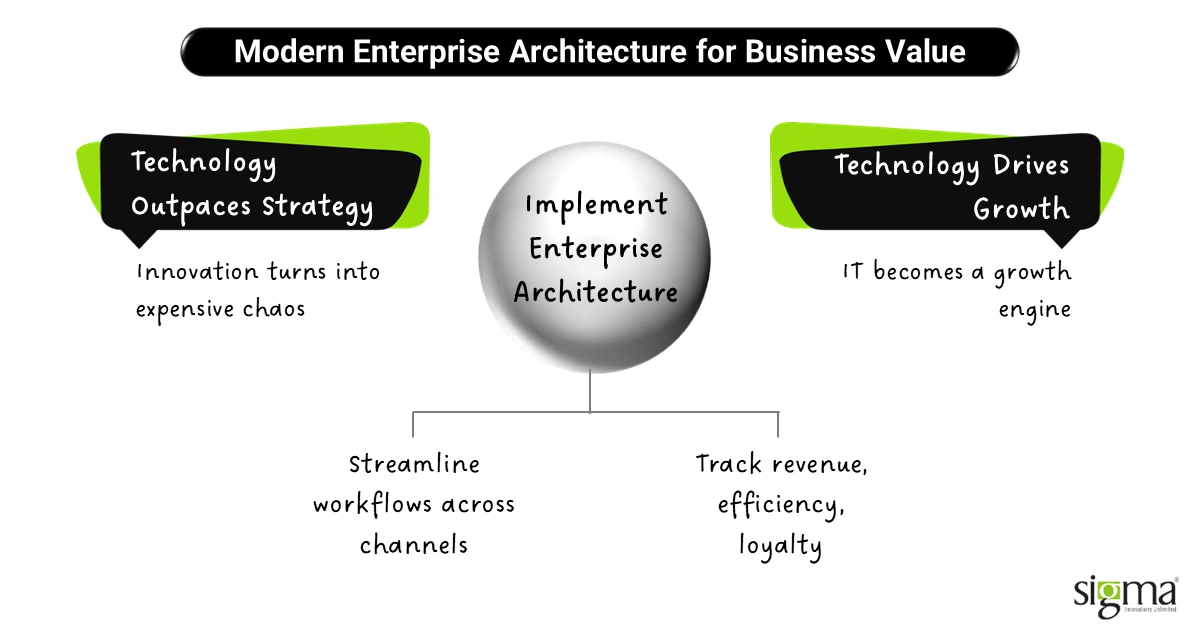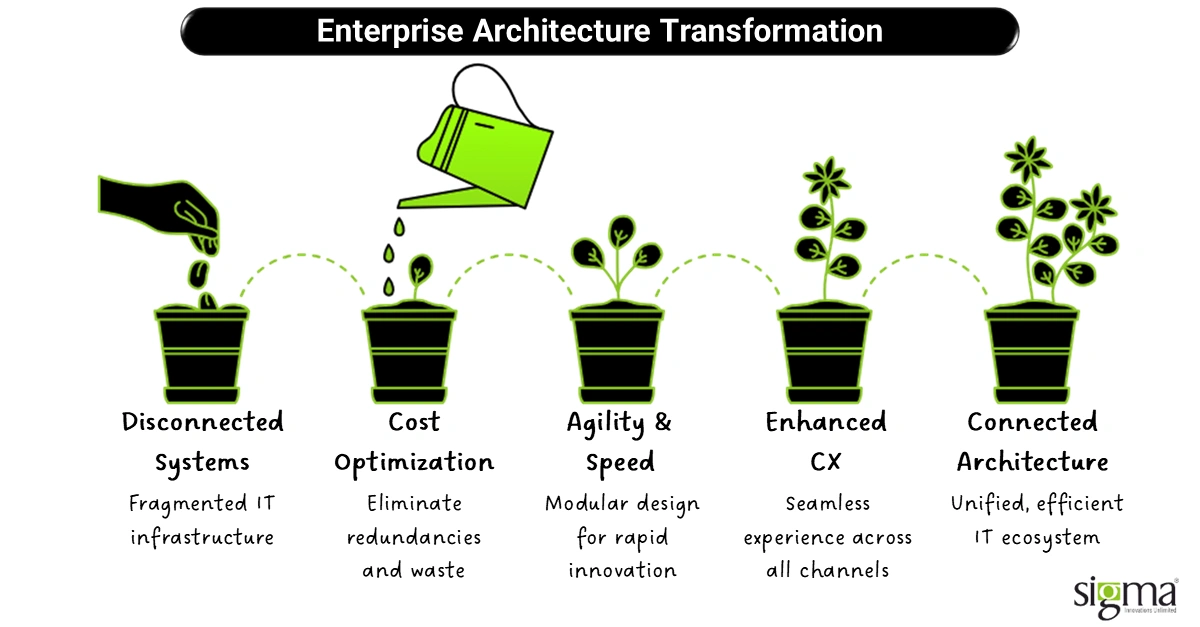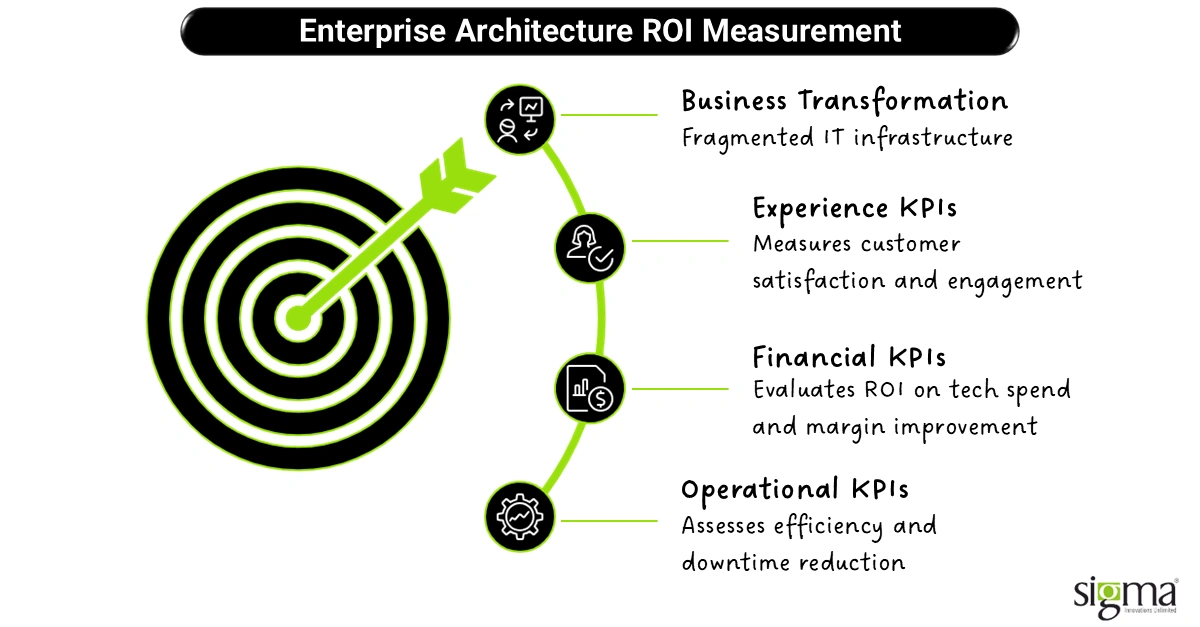ROI Beyond Technology: The Business Value of Enterprise Architecture Solutions
Key Takeaways:
- Stop chasing tools, start designing transformation. Most companies treat technology as a bandage; Enterprise Architecture makes it the backbone of growth.
- From tech clutter to business clarity. EA aligns every system and process so your digital ecosystem runs like a well-tuned engine, not a junkyard of apps.
- ROI, which means real impact. With Sigma Infosolutions, Enterprise Architecture stops being IT overhead and starts fueling measurable business momentum.
In today’s boardrooms, ROI discussions about technology sound more like post-mortems than progress reports. Despite the excitement around digital transformation, many executives are left asking the same frustrating question: “We’ve invested millions, so why aren’t we seeing results?”
Across industries like fintech, eCommerce, and product engineering, companies are pouring money into cloud platforms, automation tools, and AI systems. Yet the needle on profitability and productivity barely moves. It’s a paradox of the modern enterprise: the more tech we buy, the less clarity we have on its impact.
Digital investments fail to deliver expected ROI because of fragmented systems, siloed data, and a lack of strategic IT. What looks like a “technology problem” is often an architecture problem, a disconnect between what the business needs and how technology is structured to deliver it.
This is where Enterprise Architecture Solutions enter the conversation. Unlike point solutions or isolated upgrades, modern enterprise architecture provides a business-first framework that connects every digital investment to a measurable outcome — optimizing cost, improving agility, and enhancing customer experience.
The missing link isn’t more technology; it’s Enterprise Architecture (EA), the bridge that aligns innovation with business value. The Enterprise Architecture is evolving into a core IT pillar, with the global market forecast to reach $2.31 billion by 2035, affirming its position as a critical investment area.
In this blog, we’ll explore how a strong enterprise architecture framework can help organizations move beyond technology chaos and turn their IT spend into a predictable, measurable engine of growth.
When Technology Outpaces Strategy (The Core Challenge)
Most mid-market enterprises aren’t short on technology; they’re drowning in it. Every new platform promises agility, every integration claims to drive insight, yet decision-makers still struggle to connect the dots. The truth is, technology adoption has outpaced architectural evolution. Without an Enterprise Architecture (EA) backbone, innovation turns into expensive chaos.

Let’s be real, these struggles are common across fintech firms, eCommerce businesses, and product engineering companies:
- Siloed systems: Each department runs its own tools and platforms, but none of them talk to each other. The result? Data islands and decision-making bottlenecks.
- Inflexible IT: Years of quick fixes and outdated integrations have created heavy tech debt. Even a small change now feels like open-heart surgery on your IT stack.
- Unclear ROI metrics: You can track how much you spend on technology, but can you prove how it impacts revenue, efficiency, or customer loyalty? For most, the answer is no.
- Fragmented user experience: Disconnected workflows across channels make customer journeys clunky and inconsistent, costing businesses repeat revenue and trust.
Digital transformations stall due to weak architectural alignment and a lack of a unified data strategy. When strategy lags behind technology, IT becomes a patchwork of tools rather than a growth engine.
The fix isn’t just better tech, it’s smarter architecture. By establishing a modern enterprise architecture framework, businesses can unify data, streamline workflows, and measure what really matters: business impact.
So, how do you translate your tech investments into lasting business value? That’s where modern Enterprise Architecture steps in.
Redefining Enterprise Architecture (From IT Discipline to Business Strategy)
For years, Enterprise Architecture (EA) was treated as an IT formality — a box to tick, a document to maintain, a process meant to keep systems compliant. But in today’s fast-moving digital economy, that mindset is outdated. Modern enterprise architecture isn’t about control; it’s about clarity, speed, and growth.
At its core, Enterprise Architecture is a strategic blueprint that aligns technology, processes, and data to business goals. It’s not a technical artifact; it’s the operating model of a modern, connected business.
Let’s draw the contrast clearly:
- Old EA: Compliance-driven, rigid, and focused on maintaining documentation.
- Modern EA: Agile, outcome-driven, and designed for continuous optimization and measurable business value.
The shift is profound. Traditional frameworks like TOGAF or Zachman still matter for structure, and newer models like Salesforce’s Agentic EA bring intelligence to automation and decision-making. But at Sigma Infosolutions, our focus goes beyond frameworks. We deliver enterprise architecture design services that are results-first, not document-first — bridging vision and execution to accelerate transformation.
As we often say, “Modern EA isn’t about diagrams, it’s about decisions.” It’s about empowering organizations to choose where to invest, when to scale, and how to innovate, all backed by data and architecture intelligence.
By connecting every piece of the puzzle, from Cloud Architecture Design Solutions to Enhanced Integration Frameworks, business enterprise architecture becomes a living strategy that grows with the organization.
Now that we’ve reframed what EA truly means, let’s explore how the right enterprise architecture solutions deliver measurable ROI across three core business dimensions: cost optimization, agility, and customer experience.
Also Read: Accelerating Time-to-Market Through DevOps-Enabled Product Engineering Services
The Business Value of Enterprise Architecture
When done right, Enterprise Architecture (EA) doesn’t just organize IT, it monetizes. Modern enterprises that invest in architecture as a strategic business function are the ones turning technology from a cost sink into a measurable growth engine. Let’s break down how EA delivers real-world ROI across three core dimensions: Cost Optimization, Agility, and Customer Experience.

Cost Optimization
For most organizations, the first promise of digital transformation is savings, but without architectural alignment, costs often spiral instead. Enterprise Architecture Solutions bring control and clarity to where and how money is spent across technology ecosystems.
By identifying redundancies in infrastructure, overlapping software licenses, and underutilized systems, EA eliminates waste at its roots. It also creates a single source of truth through streamlined data flow, reducing integration errors and maintenance overhead. The result? Less firefighting, fewer vendor contracts, and more predictable budgeting.
A modern enterprise architecture framework also paves the way to shift from capex-heavy legacy systems to scalable cloud ecosystems like AWS or Salesforce. That means businesses can pay for what they use and scale up or down without financial strain.
At Sigma, one leading digital lender experienced this ROI firsthand: an Enterprise Architecture-led migration to a serverless AWS Data Lake and Next.js platform delivered a 30% reduction in infrastructure costs, while simultaneously building the scalable backbone necessary for AI-driven growth and faster loan processing.
When architecture drives the strategy, efficiency follows naturally. Cost savings are only part of the story; true ROI extends into agility and experience!
Agility and Speed-to-Market
Competitive advantage is no longer about size; it’s about the speed at which you translate insight into action. The ability to launch, test, and scale new ideas quickly separates digital leaders from the rest. Modern enterprise architecture makes that possible by bringing flexibility to every layer of your business.
With modular architectures and microservices design, teams can innovate without disrupting existing operations. This structure not only reduces development bottlenecks but also fosters seamless collaboration between IT and business functions; everyone works from the same blueprint.
Through enterprise architecture tools that align business objectives with IT execution, companies can rapidly adopt emerging technologies like AI, automation, and advanced analytics without breaking what already works.
Take Sigma’s product engineering solutions as an example. We partnered with a prominent US-based lender to modernize their platform. By migrating their monolithic application to a Microservices architecture, we created a foundation for continuous innovation. This strategic redesign dramatically automated document management and streamlined loan processing, enabling the client to operate with vastly enhanced efficiency and adaptability for future growth.
That’s the essence of enterprise IT alignment: technology that moves at the pace of business, not the other way around. But agility is meaningless without impact where it matters most, your customers.
Enhanced Customer Experience
Behind every successful digital enterprise lies one unshakable truth: customer experience (CX) is the ultimate ROI metric. The best architecture makes that experience seamless, no matter the channel, device, or moment.
A unified enterprise architecture connects systems, teams, and customer touchpoints. The result is a consistent, friction-free experience from onboarding to support. With real-time analytics and personalization powered by integrated BI systems, organizations can anticipate customer needs instead of reacting to them.
For a national provider-owned GPO, Sigma replaced fragmented Dynamics CRM with a centralized Salesforce and Pardot architecture. This foundational shift gave sales teams real-time visibility into contracts and member journeys, eliminating reporting lag. The result wasn’t just internal efficiency; it was the agility needed to anticipate and meet member expectations faster, proving architectural excellence is the bedrock of service quality.
EA also enables proactive issue resolution through better visibility. When every part of the system communicates seamlessly, customer problems get solved before they escalate. It’s not just support automation, it’s empathy engineered into your infrastructure.
And that’s the real magic of business enterprise architecture. Enterprise Architecture (EA) doesn’t just improve systems; it builds wealth, generating an average 285% ROI within a three-year window. EA creates a virtuous cycle; every system improvement compounds business impact. The more connected your architecture, the more value your technology delivers over time.
Measuring ROI Beyond Technology Metrics
When it comes to Enterprise Architecture Solutions, the real success story goes far beyond uptime reports or system performance charts. The true value lies in how architecture shapes business outcomes by improving costs, financial margins, and customer satisfaction.
Modern organizations are realizing that enterprise architecture ROI isn’t just an IT metric; it’s a business metric. To measure it effectively, companies must look beyond technology KPIs and evaluate how EA drives measurable results across three dimensions: Operations, Finance, and Experience.

Operational KPIs: Efficiency That Scales
- Cost-to-serve reduction: Streamlined data flow and process automation minimize manual intervention and resource wastage.
- Downtime minimization: Integrated enterprise architecture tools enable proactive monitoring, reducing unplanned outages.
- Process efficiency: Unified systems streamline workflows, drastically reducing the time required to complete core operational tasks.
Financial KPIs: Turning Spend into Strategy
- ROI on tech spend: A well-structured enterprise architecture framework ensures that every technology investment supports revenue growth or cost reduction.
- Time-to-value: By eliminating redundancies and reusing architecture assets, organizations accelerate transformation projects by 30-40%.
- Margin improvement: Agile architectures and Cloud Architecture Design Solutions help reduce IT overhead while boosting profitability.
Experience KPIs: Architecture That Delivers Delight
- Customer satisfaction (NPS): Integrated data architecture and BI systems deliver personalized experiences that increase loyalty.
- Retention and engagement: Consistent experiences across channels drive higher user retention rates.
- Digital engagement scores: Seamless systems encourage deeper customer interaction across mobile and web touchpoints.
Outcome-Based Enterprise Architecture
Leading consulting firms in the industry point toward a clear shift, from static documentation to outcome-based enterprise architecture. In this model, success isn’t measured by how complete your diagrams are, but by how well your architecture enables business value streams.
At Sigma, our Enterprise Architecture Solutions use a structured ROI measurement framework:
- Map business goals: Define strategic objectives (growth, efficiency, CX).
- Identify architectural enablers: Pinpoint systems, integrations, and capabilities that support those goals.
- Quantify impact: Track business outcomes using operational, financial, and experiential KPIs.
Remember, the real ROI of EA lies not in the architecture itself but in the business transformations it enables.
Also Read: Self-Service BI – The Key to Democratizing BI and Analytics Across Organizations
Turning Architecture into Advantage with Sigma Infosolutions
At Sigma, enterprise architecture isn’t a static framework but a strategic accelerator for business growth. We believe architecture should evolve at the speed of your business, enabling seamless scalability, innovation, and measurable ROI.
Our Enterprise Architecture Solutions go beyond diagrams and governance models. We build business-aligned, scalable architectures that unify systems, data, and workflows, turning operational complexity into competitive advantage. Whether it’s integrating legacy systems, modernizing to the cloud, or enabling AI-driven insights, Sigma ensures that technology is not just functional but transformative.
We don’t just build architectures; we architect growth. Our solutions are grounded in measurable outcomes, i.e., lower operational costs, faster product launches, and superior digital experiences. By aligning IT investments with strategic objectives, we help businesses transform their enterprise architecture from a cost center into a value engine.
Our cross-domain expertise is what sets us apart. Sigma brings together deep capabilities across:
- BI & Analytics – Unlock real-time insights through unified data ecosystems.
- Product Engineering – Leverage modular and microservices-based frameworks for agility.
- Salesforce Consulting – Create 360° customer views and personalized experiences.
- AI & Automation – Drive intelligent decision-making and efficiency at scale.
- AWS Cloud Solutions – Build resilient, secure, and scalable infrastructures.
- UI/UX Design – Ensure every digital touchpoint delivers intuitive, consistent experiences.
- Custom Development – Tailor solutions that align perfectly with your enterprise goals.
Our focus industries, Fintech and eCommerce, reflect our commitment to driving transformation where agility and experience matter most. From enabling digital lending platforms to powering online retail ecosystems, Sigma helps mid-market enterprises realize the full business value of enterprise architecture.
Sigma Infosolutions turns architecture into an advantage, helping businesses not only stay ahead of disruption but define it.
The Future of ROI (Enterprise Architecture as a Growth Multiplier)
Enterprise Architecture is no longer just about aligning IT and business; it’s becoming the intelligent backbone of organizational transformation. As AI, automation, and data analytics redefine how enterprises operate, EA is evolving into an AI-enabled discipline, one that is data-driven, predictive, and adaptive.
Future-ready organizations are already treating enterprise architecture as their nerve center, the system of systems that connects strategy, technology, and execution. Instead of being reactive, these architectures anticipate change, optimize continuously, and scale with business ambition.
In this new era, ROI is not measured by cost reduction alone, but by the organization’s ability to accelerate innovation, improve decision-making, and deliver value faster. The winners of tomorrow will be those who translate technology investments into business value today, turning architecture from a support function into a strategic growth multiplier.
At Sigma, we help businesses build that modern, modular, and measurable future. Our enterprise architecture solutions are designed to evolve with your business, ensuring every system, workflow, and investment contributes to lasting competitive advantage.
Explore how Sigma can help your organization transform technology investments into measurable business outcomes through modern Enterprise Architecture!
Conclusion (ROI Beyond Technology)
The pursuit of ROI in technology has often been misdirected, measured by the number of systems deployed rather than the value created. True return on investment comes not from the tools themselves, but from how seamlessly they serve the business vision. ROI is not about technology; it’s about transformation.
When enterprises move beyond fragmented adoption and embrace Enterprise Architecture as a strategic discipline, every decision, process, and platform begins to work in unison toward measurable outcomes. Costs decline, agility improves, and customer experiences become more consistent and intelligent.
At Sigma Infosolutions, we help organizations bridge this gap between technology potential and business performance. Our approach goes beyond implementation; we co-architect growth by aligning strategy, systems, and people through modern, scalable architectures that adapt to changing business goals.
In a marketplace where disruption is constant and speed defines success, the enterprises that thrive will be those that build intelligently, not just rapidly. They’ll measure success not by projects completed, but by value sustained.
